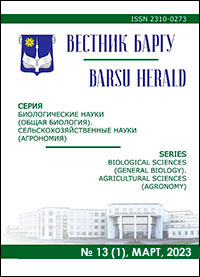THE ECOLOGICAL STRUCTURE OF TRUE BUGS (HEMIPTERA: HETEROPTERA)IN PINE FORESTS OF OAK-DARK CONIFEROUS FORESTS SUBZONE IN BELARUS
Keywords:
Hemiptera; Heteroptera; true bugs; ecological groups; vertical distribution; pine forests; BelarusAbstract
True bugs are large suborder of insects; in the world fauna, the number of species exceeds 40 000. True bugs
inhabit terrestrial and aquatic ecosystems of all continents except Antarctica, as well as the surface of the tropical zone
of the oceans. Like the vast majority of entomofauna species, true bugs play an important role in ecosystems and are
of practical interest to humans. True bugs are characterized by wide adaptive abilities and ecological plasticity, which
allow them to master various aquatic and terrestrial habitats, as well as to populate all tiers of trees, shrubs and herbaceous
vegetation and the upper soil layer. Depending on the preferred habitat layer, true bugs, like other representatives
of the biota, are divided into ecological groups. In pine cultures of different age classes of the subzone of oakdark
coniferous forests of Belarus, on the territory of Dokshitsky district of Vitebsk region, were identified 109 species
of true hemipterans, belonging to 9 ecological groups in accordance with the vertical distribution. Hortobionts
(53.2 % of all recorded species), herpetochortobionts and dendrobionts have been distinguished by the greatest species of ecological groups in accordance with the vertical distribution has been noted in open forest plantations and in pine
forests of age class III. Hortobionts occupy the dominant position in terms of the number of species in pine cultures of
all studied age categories. This ecological group is also prevailing in the number of collected specimens of true bugs.
For the ecological groups leading in the number of species and the number of specimens, the species and quantitative
composition of true bugs in all the studied age categories of pine forests have been analyzed and dominant species
have been identified.
Fig. 1. Table 2. Ref.: 21 titles.
Downloads
Published
Issue
Section
License
Copyright (c) 2023 Вестник БарГУ Серия "Биологические науки. Сельскохозяйственные науки"
Это произведение доступно по лицензии Creative Commons «Attribution-NonCommercial» («Атрибуция — Некоммерческое использование») 4.0 Всемирная.
Авторы сохраняют за собой право заключать определенные договорные соглашения, касающиеся неисключительного распространения опубликованной версии работы (например, размещать ее в институциональном репозитории, публикация в книге) со ссылкой на ее первоначальную публикацию в этом журнале.





